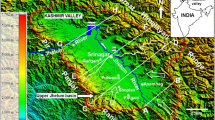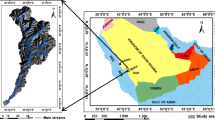Abstract
Natural climatic hazards like flood, an important hydro-geomorphic process of earth’s surface, have different regional and local impacts with significant socio-economic consequences. Similar was the case in Gujarat State, India during last week of June 2005. This study is about assessing the impact of Gujarat flood on river dynamics. It deals with extraction of water bodies information using radiance image and standard water indices i.e., Normalized Difference Water Index (NDWI) and Modified Normalized Difference Water Index (MNDWI) for pre- and post-flooding periods. Geomorphometric analysis along with drainage network extraction was done using two different Digital Elevation Models (DEMs) i.e., Advanced Space borne Thermal Emission and Reflection Radiometer (ASTER) and Shuttle Radar Topographic Mission (SRTM) and compared. Finally, depressions mapping and comparative analysis of magnitude and directional change of drainage networks was carried out. Results confirmed better accuracy of MNDWI in separating water bodies. The water bodies area increased by 10.4 % in post-flood monsoon compared to pre-flood monsoon and by 3.8 % in post-flood dry season compared to pre-flood dry season. Geomorphometric analysis indicated that ASTER DEM gave more values of maximum slope, average slope, and standard deviation as compared to SRTM. Aspects distribution algorithm did not work well in low relief regions. The drainage network generated using SRTM DEM was more accurate. The depressions identified were more susceptible to flood events. Change analysis of drainage network (deviating 100–300 m) indicated that 5.22 % points deviated between October, 2004 and 2005 and 3.18 % between February, 2005 and 2006.















Similar content being viewed by others
References
Beven KJ, Moore ID (eds) (1993) Terrain analysis and distributed modelling in hydrology. Advances in hydrological processes. Wiley, Chichester
Bhagwat TN, Shetty A, Hegde VS (2011) Spatial variation in drainage characteristics and geomorphic instantaneous unit hydrograph (GIUH); implications for watershed management - a case study of the Varada River basin, Northern Karnataka. Catena 87(1):52–59
Bishop MP, Shroder JF (2004) Geographic information science and mountain geomorphology. Springer Praxis Books, Heidelberg, p 486
Bishop MP, James LA, Shroder JF, Walsh SJ (2012) Geospatial technologies and digital geomorphological mapping: concepts, issues and research. Geomorphology 136:5–26
Chander G, Coan MJ, Scaramuzza PL (2008) Evaluation and comparison of the IRS-P6 and the Landsat sensors. IEEE Trans Geosci Remote Sens 46(1):209–221
Chen X, Vierling L, Deering D (2005) A simple and effective radiometric correction method to improve landscape change detection across sensors and across time. Remote Sens Environ 98:63–79
Frankel KL, Dolan JF (2007) Characterizing arid region alluvial fan surface roughness with airborne laser swath mapping digital topographic data. J Geophys Res 112, F02025. doi:10.1029/2006JF000644
Gao B (1996) NDWI - a normalized difference water index for remote sensing of vegetation liquid water from space. Remote Sens Environ 58:257–266
Guth PL (1995) Slope and aspect calculations on gridded digital elevation models: examples from a geomorphometric toolbox for personal computers. Z Geomorphol NF Suppl Band 101:31–52
Henshaw AJ, Gurnell AM, Bertoldi W, Drake NA (2013) An assessment of the degree to which Landsat TM data can support the assessment of fluvial dynamics, as revealed by changes in vegetation extent and channel position, along a large river. Geomorphology. doi:10.1016/j.geomorph.2013.01.011
Hutchinson MF, Gallant JC (2000) Digital elevation models and representation of terrain shape. In: Wilson JP, Gallant JC (eds) Terrain analysis: principles and applications. Wiley, New York, pp 51–85
Jackson T, Chen D, Cosh M, Li F, Anderson M, Walthall C, Doriaswamy P, Hunt ER (2004) Vegetation water content mapping using Landsat data derived normalized difference water index for corn and soybeans. Remote Sens Environ 92:475–482
James LA, Watson DG, Hansen WF (2007) Using LiDAR data to map gullies and headwater streams under forest canopy: South Carolina, USA. Catena 71:132–144
Jensen JR (2007) Remote sensing of the environment: an earth resource perspective, 2nd edn. Prentice-Hall, Upper Saddle River, p 592
Ji L, Zhang L, Wylie B (2009) Analysis of dynamic thresholds for the Normalized Difference Water Index. Photogramm Eng Remote Sens 75:1307–1317
Jones AF, Brewer PA, Johnstone E, Macklin MG (2007) High-resolution interpretative geomorphological mapping of river valley environments using airborne LiDAR data. Earth Surf Process Landf 32:1574–1592
Kundzewicz ZW, Hirabayashi Y, Kanae S (2009) River floods in the changing climate -observations and projections. Water Resour Manag 24(11):2633–2646
Lacaux JP, Tourre YM, Vignolles C, Ndione JA, Lafaye M (2007) Classification of ponds from high-spatial resolution remote sensing: application to rift valley fever epidemics in Senegal. Remote Sens Environ 106(1):66–74
Leica Geosystems (2008) ERDAS field guide, vol 2. Leica Geosystems Geospatial Imaging, LLC, Norcross, p 384
Mark DM (1984) Automatic detection of drainage networks from digital elevation models. Cartographica 21:168–178
Martz LW, Garbrecht J (2007) Automated extraction of drainage network and watershed data from digital elevation models. J Am Water Resour Assoc 29:901–908
Mason DC, Scott TR, Wang HJ (2006) Extraction of tidal channel networks from airborne scanning laser altimetry. ISPRS J Photogramm Remote Sens 61:67–83
McFeeters SK (1996) The use of the Normalized Difference Water Index (NDWI) in the delineation of open water features. Int J Remote Sens 17:1425–1432
Ministry of Water Resources (2002) National water policy. Ministry of Water Resources, Government of India, New Delhi, p 10
Mukherjee S, Joshi PK, Mukherjee S, Ghosh A, Garg RD, Mukhopadhyay A (2013) Evaluation of vertical accuracy of open source Digital Elevation Model (DEM). Int J Appl Earth Obs Geoinf 21:205–217
Notebaert B, Verstraeten G, Govers G, Poesen J (2009) Qualitative and quantitative applications of LiDAR imagery in fluvial geomorphology. Earth Surf Process Landf 34:217–231
Ozdemir H, Bird D (2009) Evaluation of morphometric parameters of drainage networks derived from topographic maps and DEM in point of floods. Environ Geol 56:1405–1415
Patel DP, Srivastava PK (2013) Flood hazards mitigation analysis using remote sensing and GIS: correspondence with town planning scheme. Water Resour Manag 27:2353–2368
Reddy GPO, Maji A, Gajbhiye KS (2004) Drainage morphometry and its influence on landform characteristics in basaltic terrain, central India—a remote sensing and GIS approach. Int J Appl Earth Obs Geoinf 6:1–16
Robinove CJ (1982) Computation with physical values from Landsat digital data. Photogramm Eng Remote Sens 48(5):781–784
Saran S, Sterk G, Peters P, Dadhwal VK (2010) Evaluation of digital elevation model for delineation of hydrological response units in a Himalayan Watershed. Geocarto Int 25:105–122
Schroeder TA, Cohen WB, Song C, Canty MJ, Yang Z (2006) Radiometric correction of multi-temporal Landsat data for characterization of early successional forest patterns in western Oregon. Remote Sens Environ 103:16–26
Serra P, Pons X, Saurí D (2008) Land-cover and land-use change in a Mediterranean landscape: a spatial analysis of driving forces integrating biophysical and human factors. Appl Geogr 28:189–209
Sharma CS, Behera MD, Mishra A, Panda SN (2011) Assessing flood induced landcover changes using remote sensing and fuzzy approach in eastern Gujarat (India). Water Resour Manag 25(13):3219–3246
Song C, Woodcock CE, Seto KC, Lenney MP, Macomber SA (2001) Classification and change detection using Landsat TM data: when and how to correct atmospheric effects? Remote Sens Environ 75(2):230–244
Strahler AN (1952) Hypsometric (area-altitude) analysis of erosional topography. Geol Soc Am Bull 63:1117–1141
Thomas J, Sabu J, Thrivikramaji KP (2010) Morphometric aspects of a small tropical mountain river system, the Southern Western Ghats, India. Int J Digit Earth 3:135–156
Thomas J, Joseph S, Thrivikramji K, Abe G, Kannan N (2012) Morphometrical analysis of two tropical mountain river basins of contrasting environmental settings, the southern Western Ghats. India. Environ Earth Sci 66(8):2353–2366
Tribe A (1992) Automated recognition of valley lines and drainage networks from grid digital evolution models: a review and a new method. J Hydrol 139:263–293
Wilson JP (2012) Digital terrain modeling. Geomorphology 137:107–121
Wilson JP, Gallant JC (eds) (2000) Terrain analysis: principles and applications. Wiley, New York
Wu S, Li J, Huang GH (2008) Characterization and evaluation of elevation data uncertainty in water resources modeling with GIS. Water Resour Manag 22:959–972
Xu H (2006) Modification of normalised difference water index (NDWI) to enhance open water features in remotely sensed imagery. Int J Remote Sens 27:3025–3033
Zhang W, Montgomery DR (1994) Digital elevation model grid size, landscape representation, and hydrologic simulation. Water Resour Res 30(4):1019–1028
Author information
Authors and Affiliations
Corresponding author
Rights and permissions
About this article
Cite this article
Sharma, C.S., Mishra, A. & Panda, S.N. Assessing Impact of Flood on River Dynamics and Susceptible Regions: Geomorphometric Analysis. Water Resour Manage 28, 2615–2638 (2014). https://doi.org/10.1007/s11269-014-0630-2
Received:
Accepted:
Published:
Issue Date:
DOI: https://doi.org/10.1007/s11269-014-0630-2




